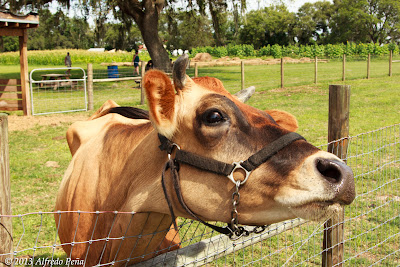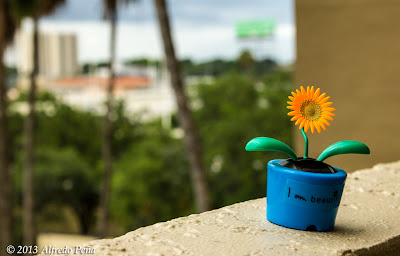Depth of field is the portion of your image that is in focus. The field is the distance in front and behind your subject that is acceptably sharp and in focus and one of the most creative tools you can use as a photographer.
In the picture below the truck in the middle is the only thing sharp and in focus, inside the depth of field. Everything else, in front and behind, is outside the depth of field.
 |
| Example of Depth Of Field |
Most photography beginners believe this is something complicated to understand and difficult to control. My hope is that after reading this entry you will have a better understanding as to how it works and that you will be able to apply it to your photographs.
A shallow depth of field is when your subject is in focus but the background is out of focus. Since our photographs are two dimensional, this is a way to create a three dimensional feel because you can see the subject forward in the image. You may have seen this effect in portrait photography. Our eyes are naturally drawn to the sharpest objects when looking at an image. With this effect you are removing all distractions in the background, guiding your viewer's eyes to your subject. You let the viewer know what you, as the photographer, consider to be the main point of interest.
A deep depth of field, normally used when photographing landscapes, is when everything in the image, from the foreground to the background is in focus.
What influences depth of field in an image
The depth of field is influenced by three factors: Aperture, focal length and the distance you are from your subject. Lets look at each one of these closer.
Aperture
Having a large aperture (small f-stop value) will have an impact on depth of field. The smallest f-stop value you can set in your camera is determined by the lens you are using. You can set the aperture value in your camera using either Aperture Priority Mode (Av on Canon, A on Nikon) or Manual mode. Don't be afraid to venture into these modes. They will make your pictures look better. For more information on aperture check out my entry on the exposure triangle here.
Here is an example of photographs taken with a large aperture at f/2.8 and another one taken at f/11. As you can see all distractions have been remove in the one taken at f/2.8, while the one shot at f/11 is very distracting with everything in focus. The beach was just as crowded in the second picture. To learn more on aperture read my entry on exposure basics here.
 |
| F/11 - Small aperture |
 |
| F/2.8 - Large aperture |
Focal length
You can create a shallow depth of field with a longer focal length, such as the ones used in a telephoto lens. A telephoto lens compresses the background making your subject stand out from the background. Wide angle lenses expand the depth of an image creating a deep depth of field so it will be more difficult to create a shallow depth of field with a wide angle lens. To do so, you would need to stand very close to your subject. This is why wide angle lenses are most often used for landscapes, when you want everything in the image to be sharp and in focus.
Below are two photographs taken from the same distance of 10 feet. One using a wide angle focal length of 24mm and the other using a focal length of 70mm. You can see the distracting background in the picture shot at 24mm, showing a deep depth of field.
 |
| 24mm |
 |
| 70mm |
Your physical distance will have an impact on the depth of field. The closer you stand to your subject, the shallower the depth of field. Take a look at the following images for example.
Below are two photographs were the same camera settings were used, aperture of f/5.6, focal length of 50mm and ISO set to 200. The only difference is that on was taken 10 feet away and the other from 3 feet away. As you can see the one shot from 3 feet away removes most of the distractions with a blurred background. Your eyes automatically focuses on the flower because it is the sharpest object in the frame.
 |
| 10 feet away from flower, f/5.6, 50mm, ISO 200 |
 |
| 3 feet away from flower, f/5.6, 50mm, ISO 200 |
Recommendations
- When photographing people and want to create a shallow depth of field, use a wide aperture. Also make sure you focus on the eyes. If the eyes are blurred the picture will be no good.
- When photographing landscapes and want everything in focus, use a high aperture value of f/8 or f/11. These are values where your lens will be most sharper.


Never thought about using focus as a defining aspect, nicely written.
ReplyDelete